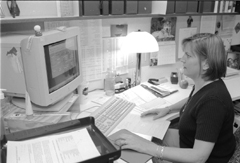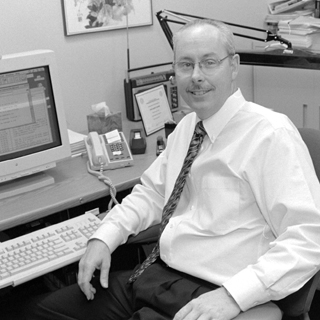The University Record, October 25, 1999 By Gretchen Weir
M-Pathways

For the last three years, administrative offices have been undergoing a huge amount of change as a result of the M-Pathways Project.
“We have learned a great deal while putting five systems into operation,” says Laura Patterson, M-Pathways Project Manager. “What we have learned about PeopleSoft has been important, but the most valuable lessons have come from users themselves. They have been very clear about what they like and don’t like.” The project’s introduction of Student Administration systems during the next five months is being shaped by lessons learned.
Do not underestimate the burden
Staff members have an added burden placed on them as they incorporate new systems into the administrative life of a school, college or department.
M-Pathways unit liaison coordinator Jan Eckert reports that some employees in schools and colleges feel their productivity has suffered because of M-Pathways.
“They feel that deans, department chairs and other faculty have expected them to conduct ‘business as usual’ when, in fact, they were having to learn many things and taking on new tasks as well.”
Mary Kurta, associate director, engineering administration, puts it this way: “We think of fiscal year 1999 as the year we worked for M-Pathways and of 2000 as the year it will begin to work for us.” Although it has taken until now, she says, to get the kinds of information she used to get in the old system, she is not discouraged. “A 12-month learning curve is not unreasonable, given the magnitude of change.” It has taken that long, for example, for the College of Engineering to redefine faculty discretionary accounts and fellowship accounts to make it easier for staff to enter data correctly.
Cathy Thibault, an accounting supervisor on the Flint campus, agrees that PeopleSoft software is a challenge for occasional users to learn.
“I see two kinds of users,” she says. “Some went all out to learn the system early on, and they are now seeing results. They are over the learning curve and finding new ways to make M-Pathways work for them. Those who resisted, thinking the system would go away, are way behind.”
Jennifer Hoy, senior accountant in the Department of Medical Education, has used M-Pathways to eliminate some old tasks. She uses the 10-character reference field to record information she used to record separately in a spreadsheet. “By establishing uniform references for almost all our transactions, we have greatly reduced the work required to classify transactions later when we reconcile monthly reports,” she says. In addition, she uses the data warehouse to create reports on this data, rather than maintaining a shadow system.
Similarly, Cynthia Sikina, director of finance in the Medical School, describes the impact of M-Pathways as a “fundamental change in the way we do things.” While the transition has been “difficult,” she acknowledges the many benefits associated with the system.
The Medical School now is generating monthly financial reports in less than a day, compared with four or five days in the past. The reports are made available “online in Excel, which gives the departments the option to tailor the reports to meet their individual reporting needs.”
The ability to run reports throughout the year-end process was instrumental in correcting errors “before it was too late,” she says. She expects “to see more benefits associated with the system as we gain more experience with it.”

Brian Moynihan, of the Information Technology Division (ITD), points out that hurdles remain. “In ITD, we’ve corrected problems with our ChartFields [the system of accounting codes used by PeopleSoft] and adjusted to a more discrete level of detail in our budgets, but we are still using spreadsheets for year-to-date information. It is very frustrating that P-Card expenses incurred in FY1999, which are several months in arrears, will not be charged to ITD statement of accounts until sometime in FY 2000.”
P-Card charges will appear sooner in reports when users begin reconciling P-Card transactions online. (Administrators assign charges to specific ChartFields through the monthly reconciling process.)
“Currently we are entering each line manually,” says Jene Janich, Financial Operations assistant manager, who oversees procurement and accounts payable. “Online reconciling will speed up the process tremendously.” Online reconciliation is being piloted in some units this fall.
Manage decentralization to minimize impact
Decentralization of tasks must be managed in order to minimize the impact on schools and colleges.
M-Pathways, when funded by the executive officers in 1996, was charged with changing how the University does its business. One of the most obvious results of reengineering in the financials area was the decision to decentralize purchasing. Schools, colleges and units will have new responsibilities in the student area, as well, but in many cases there will be flexibility in how the new duties are assigned. Offices that award financial aid, for example, will be entering financial aid award information in M-Pathways. Offices that rarely make awards can either share this activity with other units or get support from the Office of Financial Aid. LS&A has decided to enter some award information centrally, and the School of Public Health is setting up pooled arrangements.
A number of offices across campus have employed a similar strategy for procurement. Their M-Pathways “specialists” do all the purchasing for the unit.
By setting up ways of sharing new tasks, offices can reduce the number of people who will have to learn to use PeopleSoft software.
Explain the change in daily life ahead of time
Everyone should be aware of how the system will change daily roles and responsibilities before the system rolls out.
In spite of efforts to prepare schools and colleges, some faculty and staff were surprised by the changes in procurement on July 1, 1998. New procedures in those areas were not even considered until after disruptive delays in ordering and receiving.
Even in circumstances where change was expected, administrators were not always able to anticipate every consequence.
Terri Gable, senior accountant for the Museum of Art, expected to have to learn to use ChartFields, but she did not anticipate having to correct errors caused by other units using her codes.
She argues that small organizations, like the museum, would particularly benefit from being given as much lead time as possible to prepare for changes. Small administrative staffs with broad responsibilities have had to absorb many M-Pathways changes at once.
“There are only two of us and there is so much to learn,” she says. “I keep saying I’ll do my own queries in GQL or try all the standard reports, but I’m too busy trying to resolve incorrect charges.”
M-Pathways and the Financial/Physical Resources Core Process Unit expect that there will be fewer incorrect charges to resolve when units begin using “short codes.” Following the recommendation of a working group headed by Peggy Norgren of the Institute for Social Research, users will be able to substitute “short codes” to represent ChartField combinations on many of their transactions. A separate six-digit short code will be assigned to every ChartField combination.
These nicknames will be easier for faculty and staff to remember and easier to enter, but because they represent the longer ChartField combination, they will capture the same detailed information.
Break up training into small segments
Training should be broken up into small units, so users can take only the training they need, given their responsibilities.

Unit liaisons have identified student administration functions that stand alone or need to be taught to a distinct group of users. Training for these functions will be offered in separate, short sessions. M-Pathways also is using self-study sessions, when possible, to reduce the number of classroom training hours.
To help units both large and small absorb the changes Student Administration will bring, M-Pathways is:
M-Pathways systems in use across campus:
These five systems are reliably supported by a mosaic of new hardware and software, which is replacing the University’s mainframe environment.
M-Pathways systems coming soon:

